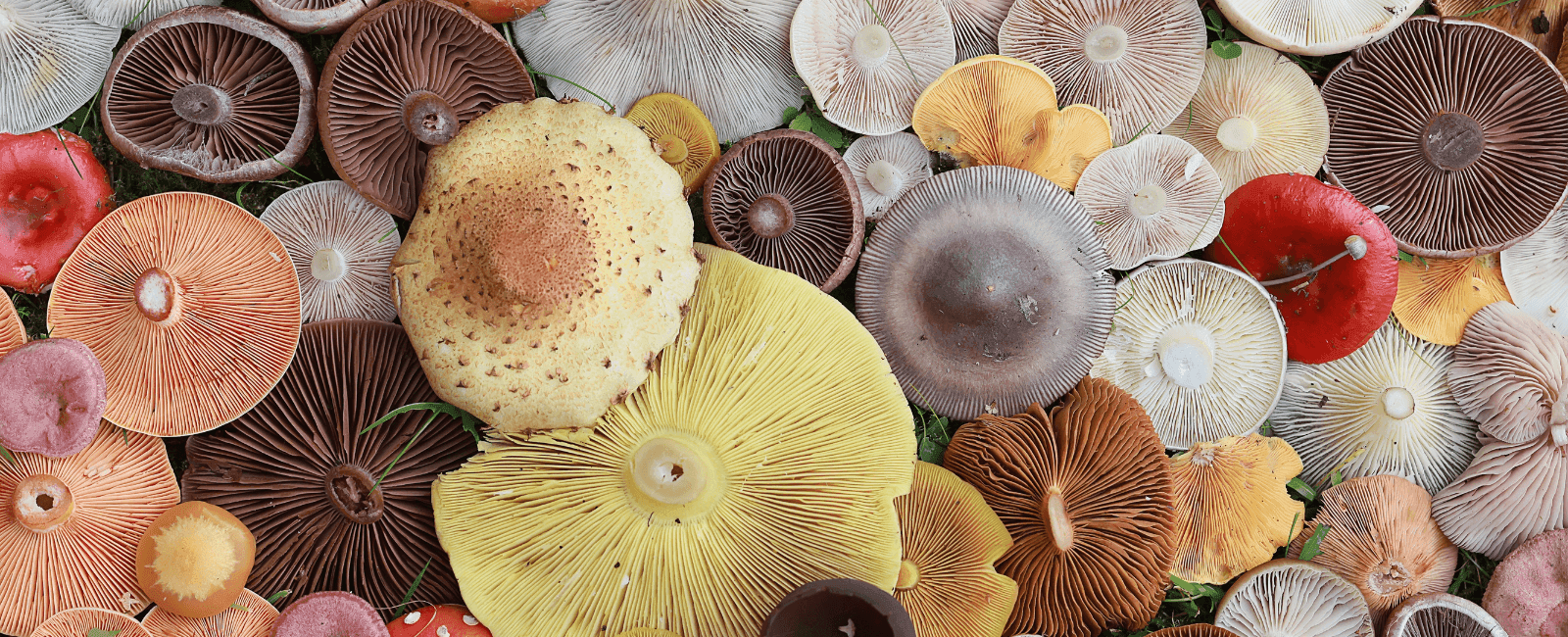

David Hibbett is a mycologist and professor at Clark University. He is one of the leading researchers in surveying fungal relationships through DNA analysis. Hibbett focuses his labs on the evolutionary biology and ecology of fungi. Recently, he partnered with WIRED magazine for their Tech Support series and took to Twitter and Youtube to answer the internet’s hottest questions about mushrooms and fungi. In his Q and A session, Hibbett covers everything from mushroom cultivation to weird mushrooms and everything in between.
Why do mushrooms have such a strange shape?
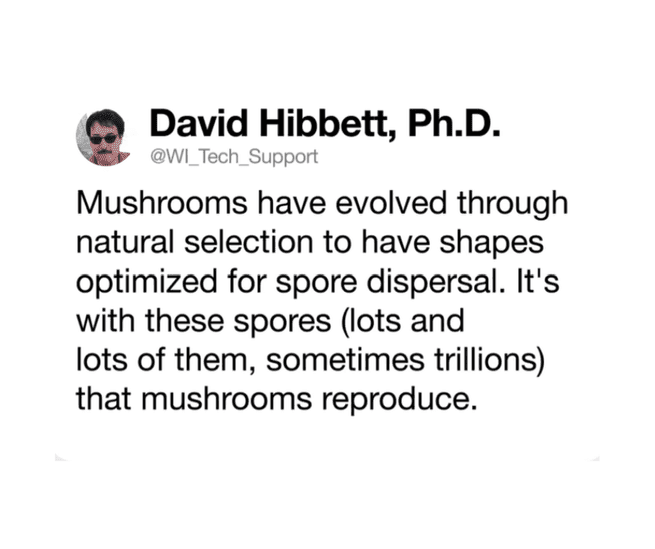
As the fruiting body of a fungus, a mushroom’s only function is to spread spores. Due to this function, the shapes of mushrooms have evolved through natural selection for optimum spore dispersal. According to Hibbett, different mushrooms can produce billions to trillions of spores in a single day. He states, “A lot of spores don’t make it. They don’t end up germinating and forming a new fungus, but the fungus makes many, many spores in order to maximize its chance of reproducing successfully.”
What’s the difference between cremini, button, and portobello mushrooms?

Basically, the three mushrooms are “all the same thing. They’re just harvested at different stages of the lifecycle,” according to Hibbett. Even though they all look distinct, they are all the same species: Agaricus bisporus. White button mushrooms are harvested very early on, so they have a closed cap, light color, and mild flavor. Cremini mushrooms are harvested in the mid-stage of their maturity, so they are darker in color with a more opened cap with a slightly more robust flavor. Finally, at the latest stage in maturity is the portobello, the fully mature version of A. bisporus. The cap is entirely brown and flattened out, and the gills are dark brown in color. By this point in life, it has developed much more flavor than its earlier stages.
A carnivorous mushroom, how scary is that?

There are species of carnivorous mushrooms, one being the seemingly innocent and highly popular oyster mushroom. Hibbett explains that the mushroom is a wood decay fungus also capable of trapping and consuming nematodes. “It does this at the level of the mycelium. This fungus produces tiny little protuberances off the sides of the hyphae, microscopic little projections from which it secretes a droplet of fluid, and that fluid contains a potent neurotoxin,” he says. When the nematode runs into the neurotoxin, the fungus grows in the worm of it and eats it from the inside out.
Why did mushrooms evolve to have psychedelic properties?

Hibbett starts this question by clarifying that magic mushrooms likely did not evolve to be hallucinogenic just for human sake. Instead, they produce chemicals to protect them from grazing insects. He mentions a recently suggested idea that the compound found in magic mushrooms, psilocybin, might interfere with digestion in slugs. “So if that is true,” he says, “then it is just a happy accident of evolution that we can get high feeding on what is essentially slug poison.”
How do mushrooms defend themselves?

Mushrooms defend themselves against animals and insects that want to eat them, but they also need to protect themselves from other fungi. They do this “by producing chemicals called secondary metabolites that effectively act as poisons,” says Hibbett. This process is visible in laboratory agar cultures but also can be seen in nature when you look at spalted wood. There are several dark lines throughout some pieces of wood that display where multiple species of fungi have colonized and interacted with eachother “in the process of fighting over turf,” leaving a beautiful pattern that is coveted by woodworkers.
What are the major differences between mushrooms that grow on wood vs. mushrooms that grow on the ground?
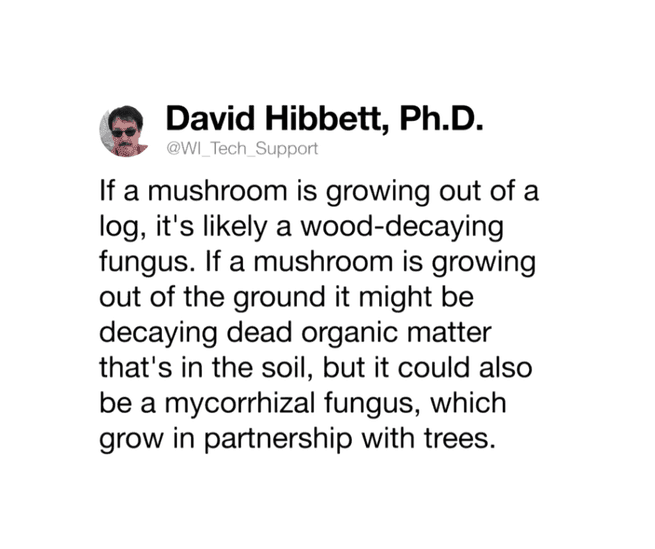
The main difference between wood-growing mushrooms and ground-growing mushrooms is that any fungus growing on a log or tree is likely a wood-decay mushroom, while one on the ground is likely decaying organic matter. Hibbett mentions that in some cases, the mushroom could be a mycorrhizal fungi which “grow in partnership with trees the fungi deliver mineral nutrients to the trees and in return the trees provide sugars which they make through photosynthesis to the fungus.”
How do zombie ants become zombies?

Hibbett asserts that the word “zombie” is misused when describing necrotrophic fungi. The zombie ant fungus (Ophiocordyceps unilateralis) does not bring ant corpses back to life but instead infects and consumes organisms to support their development. “When the zombie ants are dead, they are truly dead, and they are not coming back,” clarifies Hibbett.
Could a parasitic fungus evolve to control humans?
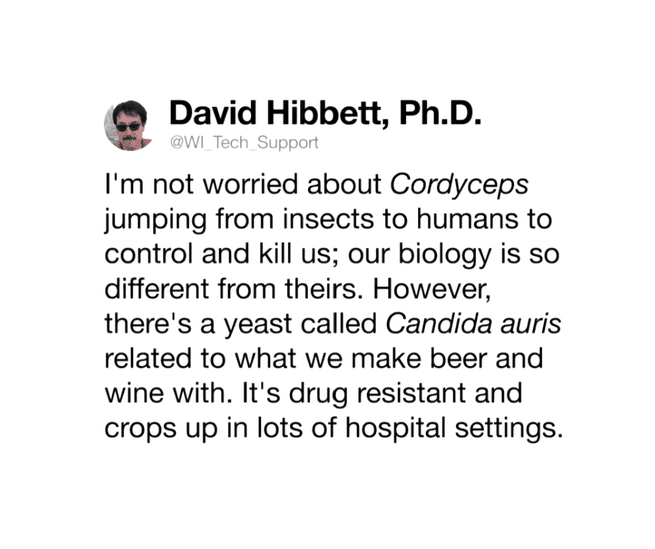
“If you’re asking, could cordyceps or one of its relatives make the jump from an insect to a human and control us and kill us – I’m not terribly worried about that myself because our biology is so wildly different from that of arthropods like insects,” says Hibbett. While fungi like the zombie ant fungi have moved on to different hosts, many of these host jumps are to other insects like cicadas or moth larvae. Hibbett states that he is not worried about these kinds of fungi, though he expresses concern over Candida Oris, an emerging yeast pathogen that is drug-resistant and a very serious, growing issue.
How do you grow mushrooms at home?

Hibbett says mushrooms are “tremendous fun” to grow at home. The easiest way to go about it is by using a grow kit that comes with an already colonized substrate block. He mentions that the only challenge is “providing the right environment for the mushrooms, and the big challenge there is humidity. Mushrooms like about 90 to 95 percent humidity in order to fruit optimally.”
Why are fungi neither plant nor animal?

“Let’s just take a step back and point out that not all of life is plants or animals. That’s a really old idea,” Hibbertt clarifies. On the Tree of Life, fungi come from the branch called opisthokonts, the same branch that animals share. Plants are further away in relation as they come from a group called archaeplastida since they gain energy from photosynthesis, unlike animals and fungi. He remarks that the plants vs. animals discourse are an outdated idea that “we’re still working hard to try to overcome.”
What’s the biggest mushroom?
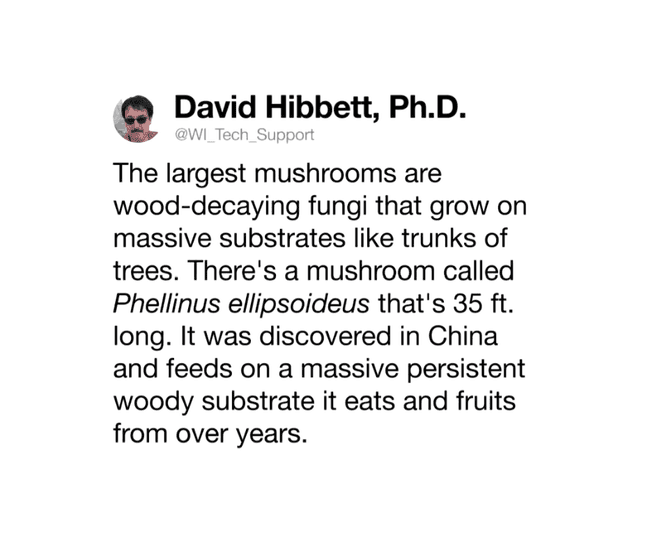
Hibbertt tells us that the largest mushrooms in the world are wood-decaying fungi that grow on “massive substrates like trunks of trees.” He gives the example of Ganoderma aplanatum, also known as the artist’s conch, which is very large in size. However, he mentions that the fungus doesn’t compare to the 35-foot-long Phalanus Ellipsodius discovered on Hainan Island in China. The fungus gets so large since it can persistently feed on a consistent substrate for many years.
Why do veiled lady mushrooms look the way they do?
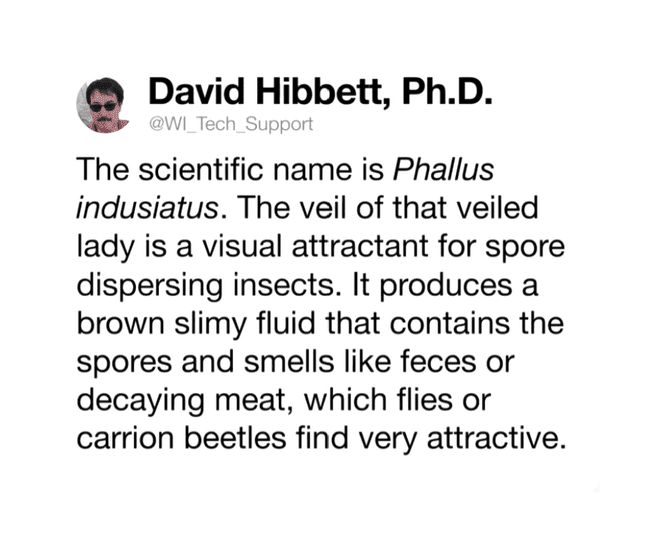
The “beautiful lace-like, veil-like structure that hangs down from” the Phallus indusiatus is referred to as a “skirt or tunic.” Hibbett mentions that scientists believe the veil is there to attract insects to spread the fungi’s spores. Just like other fungi in the stinkhorn family, the veiled lady smells of rotten meat, which further attracts spore-dispersing insects.
In your opinion, what’s the weirdest mushroom?

Hibbett believes that the weirdest, most spooky mushroom is Hydnellum peckii, or the bleeding tooth fungus. The toothed mushroom “exudes droplets of fluid on the top of the fruiting body that is bright red,” which, to Hibbert, “looks like it is dripping oozing blood.”
How can you tell if a mushroom is poisonous or not?
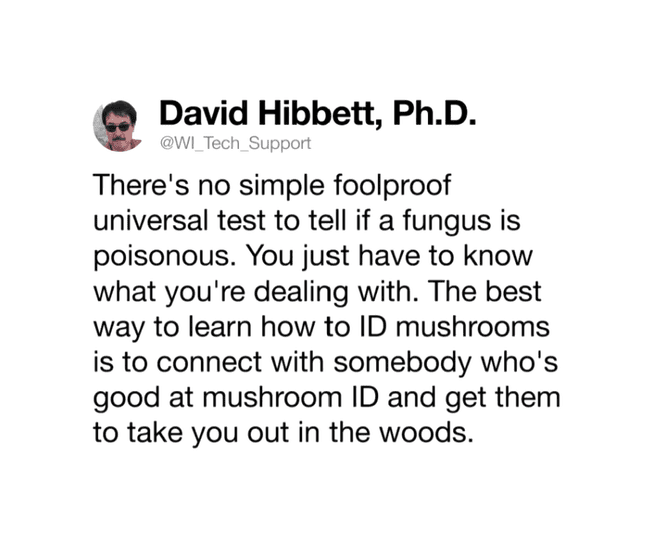
“There is no simple, foolproof universal test to tell whether or not a fungus is poisonous or not. You just have to know what you’re dealing with,” says Hibbett. Identifying mushrooms from books and websites can be difficult and not the most effective. He suggests that the best way to learn mushroom identification is to connect with an expert in mushroom ID who can take you foraging and teach you about edible mushrooms.
Do mushrooms have 50k sexes?

Hibbett explains that most mushrooms have two different mating genes, but “in order for mushrooms to be mating compatible, they have to have different variants of those genes we call those alleles so the number of sexes so to speak is determined by the number of variant alleles of each of those mating genes.” He gives the example of the well-studied common split gill (Schizophyllum commune), which can produce “28,000 unique sexes.”
Are humans and mushrooms closely related?

As mentioned earlier in the Q & A, mushrooms come from the opisthokonts family. This is the same branch that includes humans, other animals, and other forms of fungi. So, technically, they are “more closely related to each other than either is to plants,” as stated by Hibbertt.
What part of the mushroom has the spores
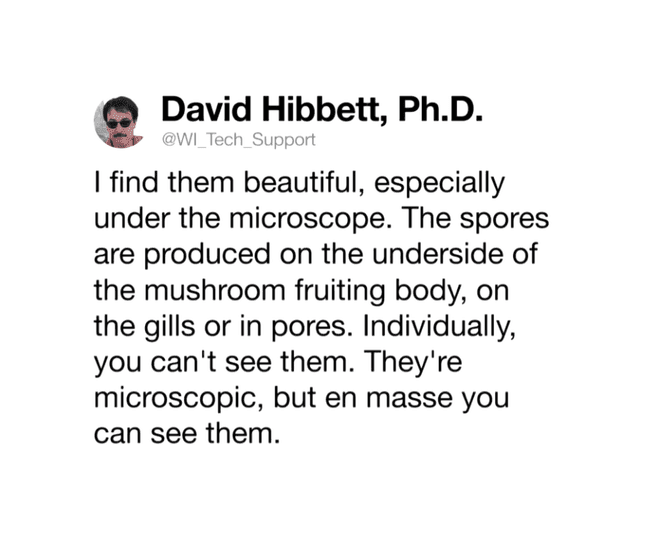
“Spores are produced on the underside of the mushroom fruiting body on the gills or in pores individually. You can’t see them; they’re microscopic. But in mass, you can see them sometimes,” Hibbett notes. If you turn a mushroom upside down on a piece of paper, you can see a spore sprint which shows the color of the spores since they’ve been deposited in such a large amount. Hibbert reveals that he finds spores “beautiful, especially under the microscope.”
What is mycelium, and what does it do?

“You can think of it as like the vegetative body of the fungus, and it’s really quite a miraculous structure,” remarks Hibbett, “it’s composed of millions of tiny microscopic thread-like filaments that mycologists call hyphae, and they radiate out into the substrate that the fungus is growing through.” Mycelium spreads through its territory, competing or mating with other fungi and capturing resources. Hibbett points out that mycelium is a significant part of a fungi’s life cycle.
Do mushrooms talk to each other?
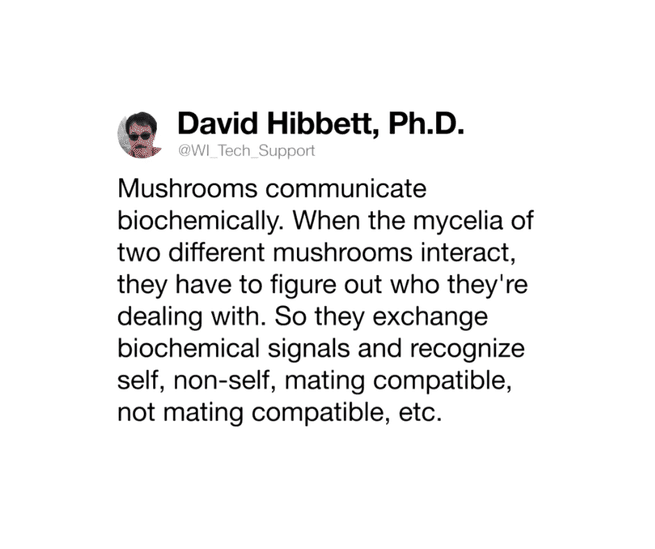
Hibbett clarifies that mushrooms don’t necessarily talk to each other but communicate biochemically. When the mycelium of a fungus runs into another fungus, they must determine if “they’re bumping into another member of their own species with whom they might like to mate or they’re bumping into a different species, and they’re going to fight with that other individual.” Based on the biochemical response, they’ll determine whether the other fungi is mating-compatible.
Are there bioluminescent mushrooms?
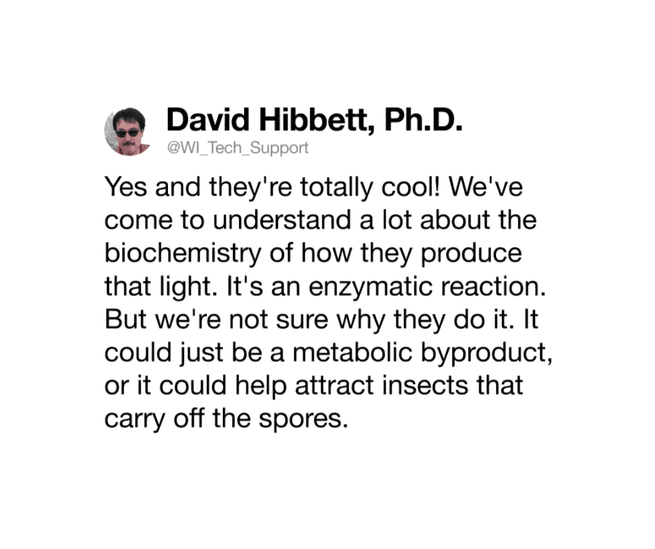
“Yes, there are bioluminescent mushrooms, and they are totally cool!” Hibbett exclaims. Though mycologists have learned a lot about the biochemistry of these mushrooms and how they produce light through enzymatic reactions, they still don’t know precisely why some fungi glow. “It could just be a metabolic byproduct. It could have no function at all, but there have been at least a couple of studies that have suggested that, in some cases, that might actually help to attract insects that might carry off the spores,” says Hibbett.
Why do magic mushrooms grow on cow poop?

Hibbett clarifies that many different types of fungi grow in animal dung, called coprophilous fungi. Overall, dung is an excellent substrate for some mushrooms, not just magic ones. It “turns out to be a really nutritious substrate for a fungus. It’s got lots of nitrogen compounds; it’s got sugars, it’s got carbohydrates.”
Why do mushrooms grow in circles?

Hibbett recounts how, in the past, people believed fairy rings were where fairies and elves danced around, and as a result, they were too afraid to step in them. We now know mushrooms fruit in a circle; “the mycelium, that network of filaments that makes up the vegetative body of the fungus, all other things being equal, in a uniform environment, will grow out in a circle.”
How many species of mushrooms are there?
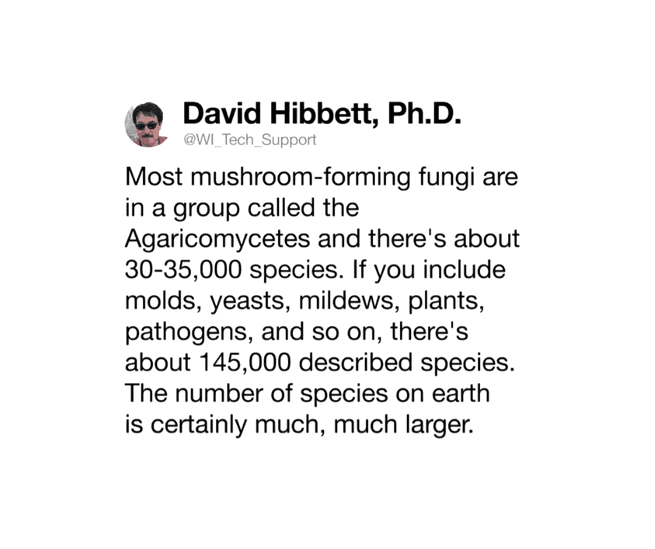
Even though people have been studying mushrooms for centuries, mycologists still don’t know how many distinct species of fungi there are. Mushroom-forming fungi in the agaricomycetes group have about 30,000 to 35,000 described species. He adds that the combination of all fungi (molds, yeast, mildews, plant pathogens, etc.) adds up to 145,000 described species to the list. Scientists believe there are around 165 million species of fungi. Hibbertt highlights, “What that means is that if you’re interested in mycology, it’s a great field to make lots of new discoveries.”
How do mushrooms grow so quickly?
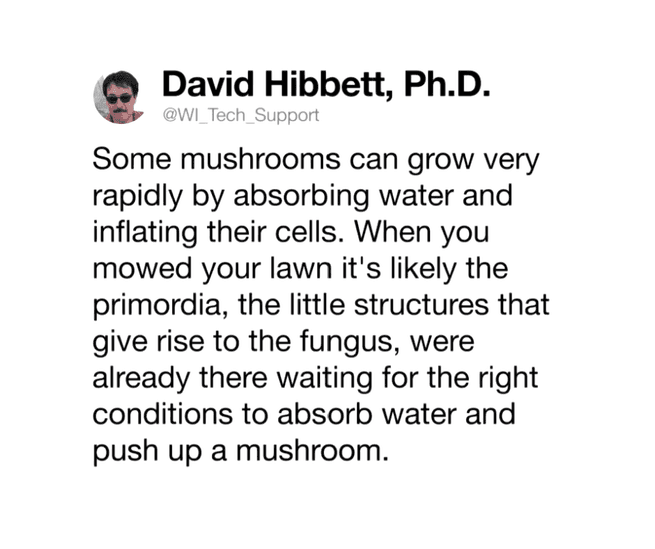
“Some mushrooms can grow very rapidly by absorbing water and inflating their cells,” Hibbett answers. There are little structures called primordia which are already waiting to grow into a fungus. Under the right conditions, Hibbett reports that a mushroom can grow very quickly when they’re exposed to water.
How do mushrooms decompose organic matter? Can they decompose inorganic matter?

Fungi break apart organic matter through the mycelium’s hyphae, which use enzymes to digest the matter into smaller molecules for digestion. According to Hibbett, this process is “not terribly different from what we do except that we digest our food inside our bodies whereas fungi digest their food outside their filaments with these secreted enzymes.” Furthermore, he clarifies that some fungi, particularly white rot fungi, can also break down matter like coal, oil, plastics, and pesticides since they are carbon-based compounds. This ability has sparked the interest of many scientists to use fungi to clean up artificial pollutants in the environment.
Why is everyone obsessed with mushrooms all of a sudden?

“Everyone should be obsessed with mushrooms,” Hibbett answers. He explains how mushrooms are so diverse. They can be edible, poisonous, or even psychedelic. And they play a substantial role in the ecosystem. “Another great reason to be interested in mushrooms is because of the people. The huge community of amateur mycologists and community scientists who get together and form mushroom clubs and go out and do forays and grow mushrooms, and they’re eager to share what they know,” he says. Hibbett urges people to join a local mushroom club so that they can become obsessed with fungi too.


